BATON ROUGE, Louisiana — For a few seconds on July 10, the ear-splitting police noisemaker — referred to as an LRAD — and the chants demanding justice for Alton Sterling awkwardly paused at exactly the same moment. I closed my eyes in relief. As if on cue, a lone cicada cried out from the tree above, the insect’s call piercing the air, but not the tension.
With my eyes closed and the cicada's solo still echoing through the sweltering heat of a Sunday afternoon in Baton Rouge, I saw neat bungalows, crape myrtles and longleaf pine trees. I imagined a crawfish boil, kids on bikes, grandmothers with church hats.
 But when I opened my eyes, we were still surrounded on three sides by an army of militarized police.
But when I opened my eyes, we were still surrounded on three sides by an army of militarized police.
Officers still gripped automatic weapons, still wore gas masks and bulletproof vests, still held tear gas cylinders ready to be fired. Gunmen peered out from quickly approaching armored vehicles, fingers still hovered only millimeters above triggers.
The protesters were still there, too, many of them young, teenagers or college students. They still had "Black Lives Matter" and "Stop the Killing" emblazoned on their shirts, fists of power and unity still rising into the air. Handmade signs still demanded justice for Alton Sterling, who was still dead.
It still looked like a war zone.
The early morning July 5th shooting death of Alton Sterling by Baton Rouge police officers is a tragedy that was caught on video by an activist and shared on social media for the world to see. What happened the following Sunday made me wonder what happens in Baton Rouge when the world isn’t watching.
In only a few hours I would go from covering a protest to being handcuffed, transported to the East Baton Rouge Parish Prison and thrown into the general population. I was arrested while trying to cover the story of young people’s reaction to the stark footage of one of their neighbors getting killed by police on video.
I’ve worked for JJIE for nearly a year, covering juvenile justice and issues of police brutality, examining a system seen by many in it to be out of control and unpredictable. As a reporter, I have always been an outsider looking in. But getting arrested and thrown in the inside was edifying. Even if the arrest was illegal and the imprisonment disorienting, being on the inside gave me a profound insight into how it feels to be suddenly thrown into the system I had been covering.
The assignment
Marco Poggio and I were on assignment for JJIE, covering youth reactions to the killing of Alton Sterling by Baton Rouge police officers Blane Salamoni and Howie Lake II.
Since the killing, which was recorded and released on social media on July 5, some residents of Baton Rouge and the nation have called for the arrest of the two officers, who are now on paid administrative leave, and a rigorous investigation into the broader practices of the Baton Rouge police department.
The night before an officer had aimed a department-issue assault-style gun at protesters and journalists — including me. While Marco edited video, I spent the morning and early afternoon emailing back and forth with a police communications person.
Now, I found myself in a sea of chanting protesters at the corner of France Street and East Boulevard in the Beauregard Town neighborhood. I glanced down France Street and saw a military vehicle and dozens of heavily armed officers marching slowly up the street, batons banging against their shields.
Another sign caught my eye: “No Justice, No Peace — We Shouldn’t Fear the Police.”
As protesters of all races chanted “Black Lives Matter” and “Take Off Your Riot Gear,” I climbed up on a hilly yard overlooking the street to get a better view. I was excited, but not fearful. Not yet.
Instead of stopping, the military vehicle rolled into a young woman holding a sign with an image of the Statue of Liberty. At the same time, an officer in a gas mask dragged a woman in a gray tank top past me and down the street — she looked remarkably calm. Hundreds silently screamed, the sound of their shouts drowned out by the blaring LRAD.
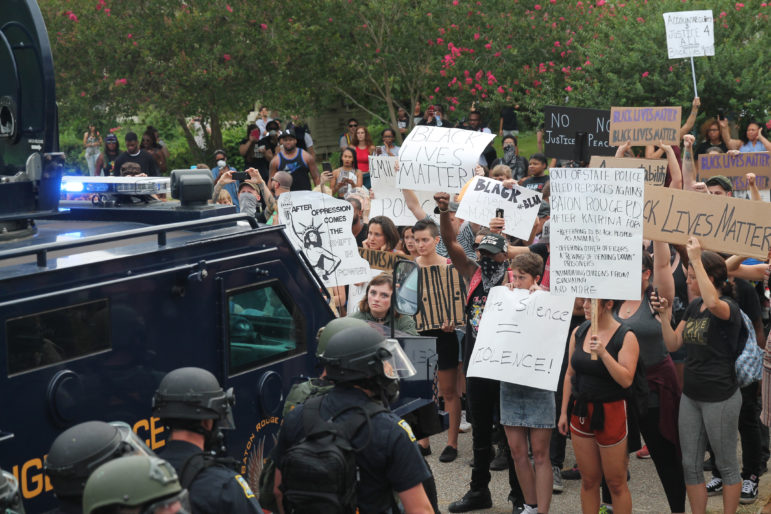
Photos by Karen Savage
An armored vehicle pushing into protesters in Baton Rouge on July 10, 2016. Protesters are calling for justice for Alton Sterling, who was killed by Baton Rouge police on July 4, 2016.
Then, just a few feet in front of me, at least eight white officers suddenly tackled a black man in a blue shirt, pushing him to the ground and handcuffing him as he tried in vain to protect his camera.

Police wrestle a young man with a camera to the ground during a protest in Baton Rouge on July 10, 2016.
Somewhere between the close call with the tank-like vehicle and the vicious takedown of the man with the camera, my excitement at covering a breaking news story started to turn into fear.
I’d been to protests in New York, Boston and elsewhere and have encountered heavily armed police. I’d seen armored vehicles and heard LRADs before. But never before had I witnessed officers risking the safety of so many, including themselves — not on the Mass Turnpike in Boston, not in Times Square and not more recently on Fifth Avenue in New York City, where I had covered anti-police brutality protests before being sent down to Louisiana.
In Baton Rouge, it seemed as if the police came ready for war.
Amid the mix of cops, protesters, guns and cameras I recognized a female officer with a ponytail and a purple T-shirt. It was the officer who’d pointed the long gun at me the night before.
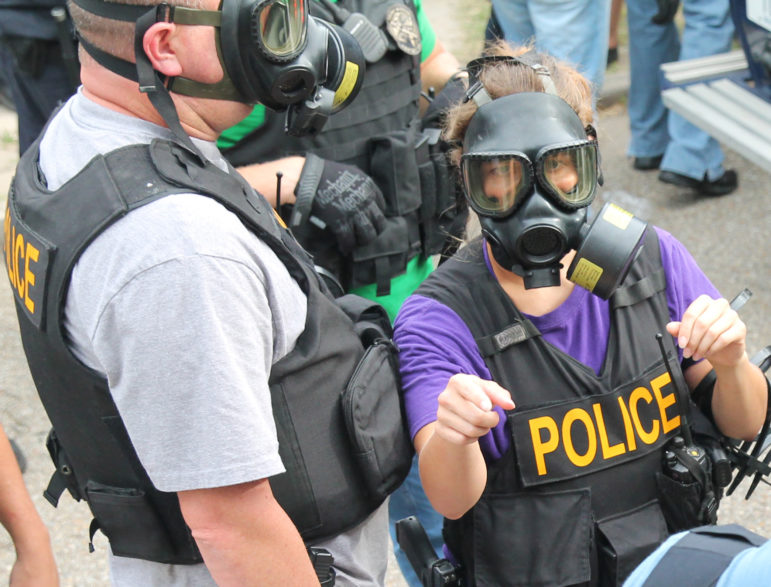
A Baton Rouge police officer (purple shirt) was back on the street less than 24 hours after pointing a long gun at a JJIE reporter during a protest on Airline Highway the night before.
A weird part of me hoped she would recognize me. I wanted to ask where was her long gun now. Did her commanding officer take it away like I used to do my kids if they didn’t play nice with their toys?
If she recognized me, she didn’t let on, but an officer in a gas mask and a green T-shirt looked straight at me, almost as if posing for the camera. I got off a few good pictures before he barked at me to get down or I would be arrested, a threat I believed. Police had arrested at least two journalists the night before.
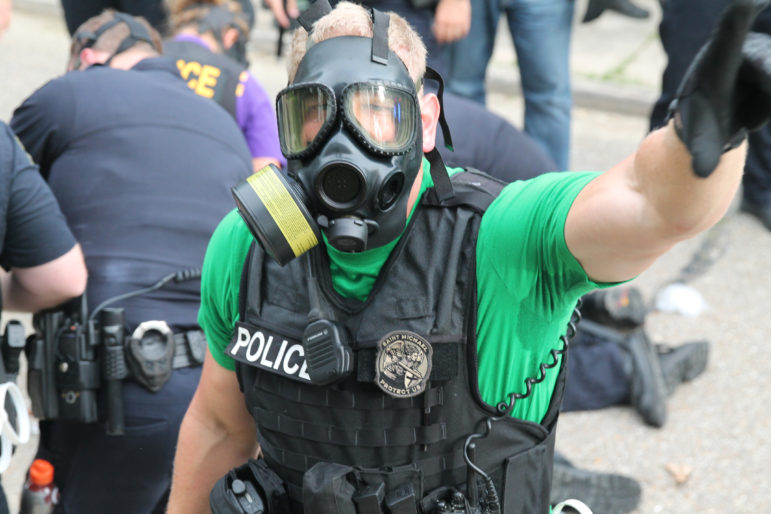
JJIE
An officer demanded a JJIE reporter standing on private property move or be arrested during a protest in Baton Rouge on July 10, 2016.
So I jumped down and ran behind a different group of officers. I filmed as they chased an older black man wearing dress pants and a vest. I tried to keep the camera steady while officers tried to block me from filming their colleagues twisting back the elder’s arms and smashing him to the ground.
I looked up to get my bearings. I was on France Street, just west of East Boulevard.
The next 40 or so minutes was an uneasy calm, like finding yourself in the eye of a hurricane. Police lined up on three sides facing the protesters, who were cornered. While Marco took video, I charged my phone with a portable charger and shared a few uneasy laughs with the people around me.
A legal observer in a neon green hat used a Sharpie to write an emergency number for the National Lawyers’ Guild on the arms of protesters.
The sun sunk low in the sky. I shot a video of the two bungalows across the street drenched in evening sunlight, as protesters shouted, “Black Lives Matter” and the police stood nearby. I’d just published the video on Twitter when a voice crackled over a loudspeaker.
#BlackLivesMatter in #BatonRouge #AltonSterling pic.twitter.com/hOVrjTY3O9
— Karen Savage (@mathsavage) July 11, 2016
“Leave now or you will be arrested,” said the voice.
Protesters moved back. The voice said, “That’s not good enough.”
A minute later, an invitation from a nearby resident began to ripple Occupy-style through the crowd. The woman welcomed protesters to seek safety in her yard. Thinking they would be safe on private property, they poured onto her green grass at the southwest corner of the intersection.
I thought about following them into the yard, but decided to stick with the sidewalk. The yard was crowded and I was afraid I wouldn’t be able to move around to get pictures. I was still wondering whether or not I’d made the right choice when the mostly white officers in full combat gear stormed the yard. From where I stood it was an unprovoked attack on peaceful protesters.
Everywhere I looked, officers chased down petrified young people, brutally dragging many into the street and arresting them. Protesters yelled, screamed, ran through yards and jumped over fences, trying not to trip over each other as they fled. Terror filled their faces as they dropped their signs and ran for their lives.
In the face of the assault, I witnessed only nonviolent reactions from the protesters. Most were easily overpowered during the violent attack by police. To my right, three white officers held a black man in a red shirt face down on the concrete. A black officer kept watch while others tried to block the scene from onlookers’ cameras.
With one of the officer’s knees pressed into the back of his neck, the man’s mouth formed as if to call out, but his scream was drowned out by sirens and yelling and sounds of other people screaming.

Officers make an arrest during a protest in Baton Rouge on July 10, 2016.
After that it seemed like officers picked us off one at a time. As I ran with the crowd I worried about Marco, who I’d lost sight of in the chaos.
A woman in a dark T-shirt ran alongside me until she was tackled by two officers as a larger officer with a rifle stood watch. I felt helpless — there were three officers on her and they had guns, armor, tasers, gas and batons.
“Run!” she yelled.
Looking down from the tree, the now silent cicada must have been horrified.
Officers zip-tied and dragged people — sometimes on their feet, sometimes on their knees or back — down the street. I wondered for a minute where they went after they left the immediate area.
I peered behind the gas masks and face shields into the officers’ eyes. Many seemed vacant and prepped for battle. From their almost mechanical behavior, it felt as though they'd prepared to battle Iraqi insurgents or Taliban fighters.
A few looked scared. One looked sick to his stomach, perhaps wondering if his neighbor or barber or daughter was among the crowd.
The three large groups of police then joined together to form one larger force. An army of police stretched out across France Street, spilling over the sidewalk, up onto neatly cut grass and all the way to the sides of the houses on one side and into parking lots on the other.
#BlackLivesMatter #BatonRouge pic.twitter.com/hvfftFLxCr
— Karen Savage (@mathsavage) July 11, 2016
They told us to get out of the street, but there was no way to get out. The protesters were surrounded. So was I.
The arrest
Since taking a picture of an earlier arrest, I felt like one of the officers was following me. I thought I might just be paranoid, but it seemed as if he was coming toward me when the commanders called officers back into formation at the intersection.
Those who seemed to be the police department’s main targets — a few young black men leading a now much smaller group — continued to walk peacefully down the street with their fists in the air.
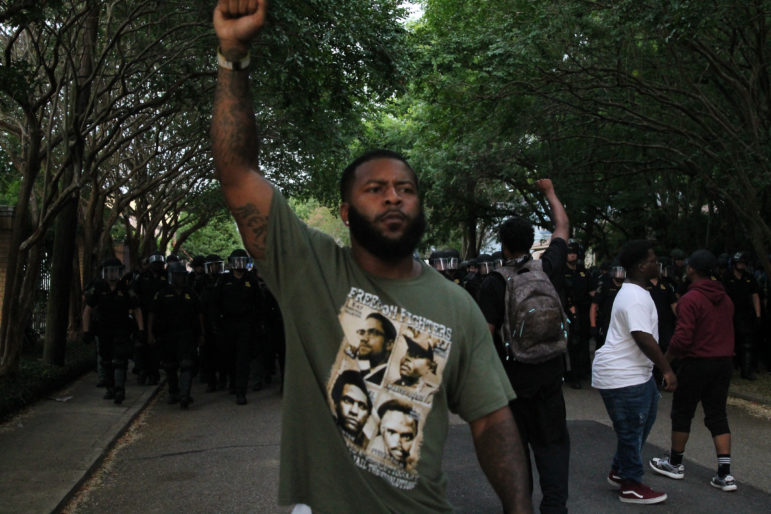
A line of police follow a man as he marches down the street during a protest in Baton Rouge on July 10, 2016.
I tried to get good pictures and saw three armored vehicles following the line of officers down the street. From the kitchen windows of nearby houses, it must have given the impression of some sort of demented military parade.
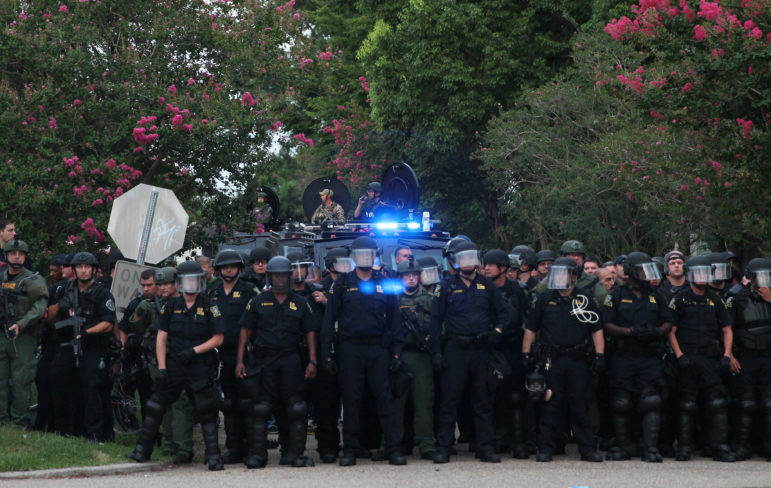
Three armored vehicles following a line of police down a Baton Rouge street during the protest.
Then, again with no provocation, the police charged. The last protester I saw was a young white woman, fear etched on her face, running from seven or eight red-faced officers.
As I ran through a fast food restaurant’s parking lot, I heard heavy boots behind me hitting the pavement. The sound of the boots became more muffled as they followed me off the asphalt onto a landscaped area. I headed for the restaurant’s door, reminding myself that I had press credentials in my right pocket.
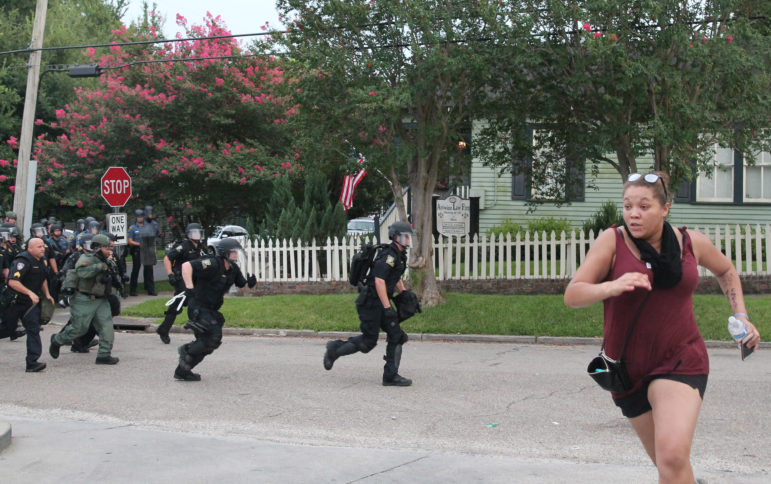
Police chase a protester during a protest in Baton Rouge on July 10, 2016.
I never made it to the door.
He grabbed my arm from behind and pulled me backwards, then shoved me forward again. I fell into the rocks and shrubs and dirt. Bizarrely, I worried more about breaking the camera’s lens, which I’d borrowed from my school’s equipment room, than about myself.
As he yanked me back again, I fell, then tried to get up.
“Are you resisting?” he asked.
“I'm a journalist, my credentials are in my right pocket, you can take them out,” I said, using the calmest voice I could muster.
“Fuck you, journalist,” he shouted from behind my ear. “You don’t listen.”
I felt hot breath on my neck.
He pulled my arms back, forced my hands together and pulled the plastic cord of the cuffs. Instantly it felt as if lightning bolts shot through my left wrist and hand. I tried not to wince as he dragged me out of the shrubbery, across the parking lot and into the street.
See story and slideshow in Bokeh: Violence by Police, Against Police Risks Tearing Country Further Apart
“Could you loosen it a little? Please,” I asked, trying to sound casual.
“Which one hurts?” he replied.
I nodded silently toward my left hand, now puffy and bluish red.
He grabbed the plastic cuff on my right hand, grunted and pulled it tighter.
“Motherfucker,” I thought to myself.
The pain made me dizzy and I tried not to fall.
I wished it didn’t hurt. Partially because it was painful as hell, but mostly because I didn’t want to give him the satisfaction of knowing he’d hurt me.
“Take it off,” I demanded, still trying to act tough.
A grinning cop in the passenger seat of a white police van held up a military knife with serrated edges and a sharpened tip.
“Want me to use this?” he asked with a smirk.
“Fuck you,” I said.
I heard someone yell my name and I turned to see a friend up the block. I tried to shout my editor's email address to her, but it was hard to remember. The pain in my wrists was shooting up my arms.
“Shut up, or we'll arrest her, too," said the officer with the knife.
Then the officer who caught me dragged me back toward the yard on East Street.
About halfway there, he slowed down, leaned close to my face, pulled my arms down and yelled again, “Fuck you, journalist.”
Maybe his buddies were watching, maybe he thought it made him look tough. Or maybe he’s just an asshole, I thought.
After what seemed like an eternity, he handed me over to a slightly less pissed-off cop.
By then I couldn’t stand straight, the pain in my left wrist was unbearable. The less pissed-off cop looked at my hand.
"What the hell did they do to you?" he said.
He asked another officer for clippers to cut the ties and someone said to take me to female transport, which was a few blocks further.
At the female transport area, a different male officer struggled to wedge what looked like pruning shears between the ties and my left wrist. We were both dripping with sweat, and the clippers slid sideways on my skin, but wouldn’t go under the plastic band.
The officer told me I had to hold still and then rammed the tool under the plastic tie. The edges of my vision grew dim and I could hear myself scream. Finally, the left cuff popped off, then the right. I could breath again.
The officer quickly pulled back my hands and put on more ties. They were still painful, but not excruciating like the last pair.
He sat me down on the curb with about 20 other women. A female police officer said my earrings could be used as weapons and she put them in a clear bag. Then she took off my gold chain, the one with the “#1 Mom” charm that my children had given me years ago.
I was still thinking about the necklace when I realized my phone was in my back pocket. They took my earrings and necklace, but they didn’t take my phone. I decided to keep doing my job as long as I could, taking pictures of the women next to me and of officers loading other women into the vans.
I expected that they’d take it at any moment. So I maneuvered the phone out of my pocket and called Daryl, my editor, to tell him what happened. I added Marco to the call and we talked for a few minutes, but then I lost them both.
I forwarded Daryl the pictures and videos I’d taken throughout the afternoon and returned a text to my daughter, Aiesha, to let her know I was ok. She had already learned through Facebook that I’d been arrested. For a minute it felt like the world really was watching.
I told Aiesha to make sure everyone knew what had happened, to let people know this was an attack on peaceful protesters. She told me she loved me. After a few minutes, an officer noticed and snatched my phone.
The woman to the left of me introduced herself as Tammy. She tried to comfort her daughter, who was crying. Tammy said they had been to the protest with her 5-year-old son, A.J., and their puppie, Kelso. Tammy and her daughter, Alexus, were taking turns staying with A.J. in the car when suddenly police swooped in, eventually arresting them both. She said officers pulled Alexus, 17, out of the car as her little brother watched.
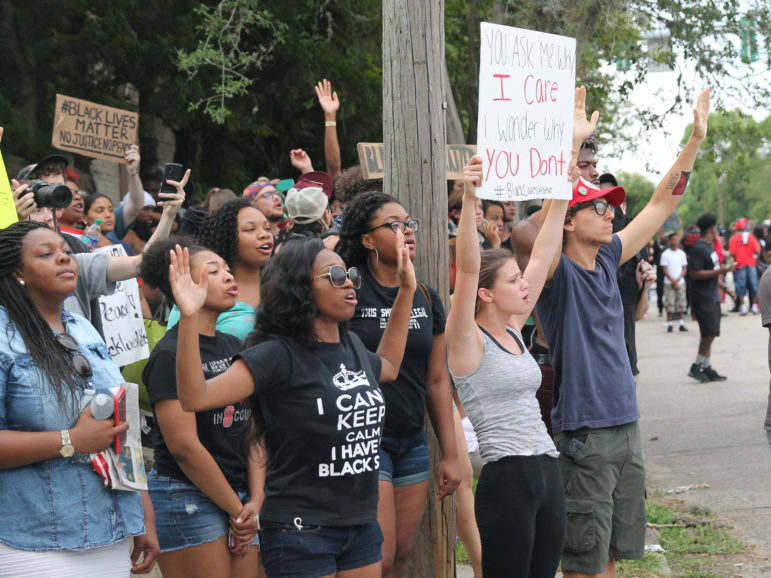
Alexus Cheney holds a sign before her arrest at a peaceful protest in Baton Rouge on July 11, 2016.
Tammy said police told her she would be charged with abandonment of her son, who would be turned over to Louisiana’s Department of Social Services. I turned my head to hide the tears I felt rolling down my face.
The woman to my right said she was standing with her husband when they were both tackled by a gang of officers. As we talked, I noticed the curb felt oddly smooth and cold in the sweltering heat. Then realized I wasn’t feeling the curb at all. My hand was numb.
The transport
After about an hour, an officer walked me to the transport van. Dolly Parton’s “Coat of Many Colors” played on the radio and the air conditioning was running full blast. Both were a welcome relief and I felt relatively safe for the first time in a few hours. I sunk into the soft bench-style seat.
Officers eventually squeezed 14 of us into the back of the van. There were only 13 seatbelts, but it didn’t much matter, since we were still zip-tied. We couldn’t put them on and officers didn’t bother. I thought of Freddie Gray in the back of an unpadded police wagon and of rough rides as the women around me talked and laughed nervously.
The woman next to me, whose name was Sophie, still had her phone. I leaned forward to block the screen’s glow from lighting up the dark van while she twisted her still-cuffed hands and typed out messages for our families. She posted audio on Facebook as I interviewed Tammy and Alexus.
About 20 minutes later, the van’s female driver turned into a driveway at the East Baton Rouge Parish Prison, pulled through a set of security gates and up to a door.
A female officer took us out of the van and lined up against a barbed wire-topped fence. When a male officer came out of the heavy door, we were told to enter. Another male officer told us to sit down on the benches that lined the hallway.
One by one, sheriff’s officers asked for our date of birth and the correct spelling of our names. They cut off our zip-ties and took any remaining jewelry from us, including a small bracelet I still wore.
After a few minutes, the officer led us through more doors and a metal detector, then past two cells filled with at least 15 men. Officers lined us up on a dirty cinder block wall around the corner from the men. I smiled with relief when a friend called out to me from behind the pink bars of a women’s cell, which was on the end of a longer row of six or seven 8- by 12-foot cells.
All were empty except the pink cell, which was on the end, and the one next to it, which already held about 15 women each.
A male officer opened the pink cell door with a metal two-pronged key and told seven or eight women on the wall near me to go in. When there was no more room, he slammed the pink sliding metal door shut.
The officer told the rest of us to go into the cell next to the pink cell. He slammed the dirty tan barred door and smirked.
“Stay quiet,” he said.
Four of us sat uncomfortably on each of the two wooden benches that lined opposite sides of the cell while Ki, who had been in the van with us, figured out how to use the phone and called the number written on protesters' arms. In the back, a short partition provided little privacy for anyone who needed to use the dirty metal toilet. Ki patiently relayed our names and birthdays to the National Lawyers’ Guild volunteers on the other end of the line.
Formerly incarcerated people I’ve written about have almost all told me one of the worst parts about the experience is not knowing what will happen next. I have a fairly decent idea of how the legal system is supposed to work, but it was little help. I didn’t know what I’d been charged with or if it was a charge with a preset bail.
Once Ki hung up, the phone worked only sporadically. When I last spoke with my editor, I didn’t know where I would be taken. Now I had no way to tell him where I was.
It made no sense to me that we were in a prison, not a jail. I later learned from staff that it was because the system was utterly overwhelmed by the number of protesters arrested by police.
For the next five hours we stayed in the cell except when the guards pulled us out a few at a time for fingerprinting and mug shots. Both male and female guards seemed to enjoy slamming the door each time anyone came or went. Maybe they felt powerful because they could make a big noise.
Even with some of us sitting near the now-plugged-up toilet, there wasn’t even enough room on the floor for all of us to sit down. A woman standing near me said her name was Jordan. As we talked, she told me she had two young boys.
Jordan said she already worries about what the police might do to them when they’re teens. She brought them with her to the protest on Friday night because she wanted them to know adults cared about them. She said she was arrested on Saturday on Airline Highway while draped in a flag.
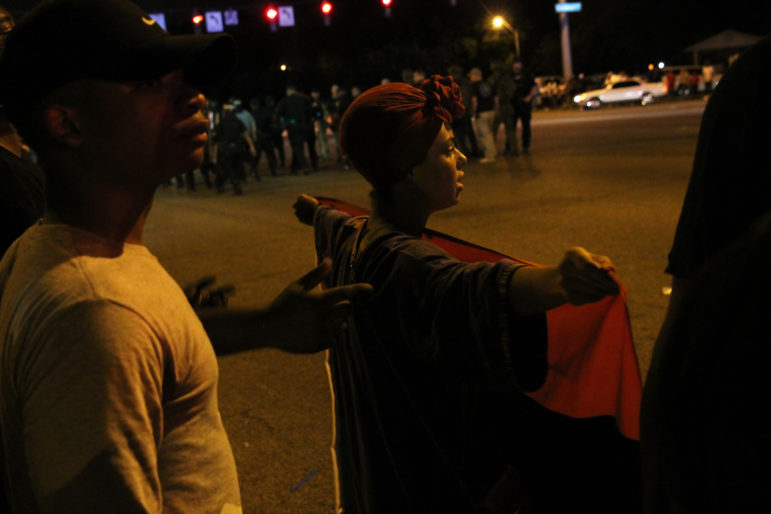
Jordan, a Baton Rouge resident and mother of two, was arrested on Airline Highway. She said she is demanding justice for Alton Sterling and already worries about the safety of her two young boys.
Only a few of the young women with me had been in a cell before and at one point they started to sing to keep their minds off the deplorable conditions. Their song drew the attention of a fat white officer named McGraw. He sauntered over, pointed to a canister near his pocket and issued an ultimatum: Shut up or get maced.
Like the cicada, they stopped singing.
A while later, a pepper spray-like smell drifted into our cell. As we sneezed and coughed, someone said the men's cell had been gassed. They cheered the release of male protesters who were arrested the day before.
A few hours later, as I sat on the floor near the toilet, I looked at my knees. I noticed for the first time they were scraped and bleeding and realized they hurt. My pants were ripped and so was one of my shoes. Now that I was paying attention, I felt a pain in my right ankle. My left hand was still numb and my right hand tingled. I was exhausted.
And I was worried about Marco. I didn’t know where he was or if he’d been arrested after we talked.
Throughout the night we rotated, taking turns sitting and standing in the tiny cage and I tried to remember to count whenever anyone was put in or taken out. The most I counted was 24 and the pink cell next door was just as crowded. Tammy and Alexus curled up next to each other between a bench and the toilet. A few of us tried to sleep, but the light, the noise, the cold and not knowing what would happen next kept us awake.
At about 3:30 a.m. I was sitting on a corner of the bench leaning on the tan metal bars when a female officer opened the door. She called five or six of us to line up on the wall outside the cell and led us down the hall, past two or three empty cells.
At the end of the hallway, we stood against another wall and she threw us each a clear bag filled with dark green prison garb. Three at a time she directed us into a small closet-like room and told us to take off everything but our panties and put on the clothes in the bag.
My shirt was enormous — the arm holes extended down to my waist — but at least my pants stayed up. When I put on the tan slip-on house shoes, I noticed my sock was stained with blood.
As soon as we all changed, the officer lined us up on the wall again and led us through a door to a covered walkway. Sharp razor wire glistened menacingly above, but the warm, humid South Louisiana air wrapped itself around my tired body and I relaxed a little. The guard told us to stop and we waited for a dark metal door to open.
The inside
A female guard opened the door from the inside and icy cold air poured out. She told us to walk through the door and line up against a wall. I could feel condensation on the cold cinder block wall.
Another female guard told six of us to go through another door. The tiny room had stacks of VHS tapes and a few books. A small handmade sign on a rickety bookcase said, “Law Library,” but looked more like a junk closet, with chairs, boxes and bags thrown haphazardly around the room.
The guard pushed a few boxes out of the way so we’d all fit in the room. She closed the door.
She told the six of us — including 17-year-old Alexus — to take off all our clothes, squat and cough. There was absolutely no privacy, everything had to come off. I looked down at the floor and felt cold air hit my skin.
When everyone was done, the officer told us to put our clothes back on. She led us out of the room and again lined us up on the wall.
I was surprised when another guard appeared from around a corner and passed out blankets that were still warm from the dryer. I wrapped myself in the thin blanket and closed my eyes, relieved to be fully covered.
The guard who did the strip search told us to walk to the next door, where another female guard assigned us to our cell lines. I was assigned to line S-01. I wondered what the “S” stands for.
The dormitory-style cell’s 20 bunk beds were mostly filled and cots lined an outer common area. Guards directed a few of the women with me to fill the rest of the bunk beds and sent the rest of us to the cots.
I laid down and pulled the thin blanket over my head. I was exhausted, but couldn’t sleep. I worried about my friend back in the pink cell. I wanted to know where Marco was. I thought about my four children, who can now boast that both of their parents have done time in prison.
I thought about how absurd it was that prisoners in Louisiana’s Angola prison had to sue the state because temperatures in their cells often soared into the triple digits while the same state was freezing my ass off with this air conditioning.
About an hour later bright lights came on and a guard told us to line up for breakfast. It was 4:15 a.m. Breakfast was pancakes and something that looked like sausage. To drink we could choose two: water, orange-colored water or coffee-colored water. After breakfast, we came back to the line and did absolutely nothing.
The majority of the women had been there since before the protests and the increase in arrests began. A woman said the guards placed the cell on lockdown because they’re short-staffed and can’t handle the influx of protesters. She said she didn’t like lockdown, but respected the protesters.
I’d spent most of the spring working on a story on parole and wishing I had access to incarcerated women. Here I was, suddenly inside, surrounded by incarcerated women, most of whom were there for crimes other than protesting, all with a story to tell.
Somehow the regulars knew when the morning inspection started. An older lady told me to hurry and make my bed. I spread the thin blanket over the moldy, stained mattress and tucked it in.
Later in the afternoon, we were lined up and taken to “see” the judge, which was really a Skype-like call to Judge Bonnie Jackson. For the first time, we were read our rights and she informed us of the charges against us. Like all the women arrested with me, I was charged with obstructing a highway and resisting arrest.
A few minutes after we left “court,” I was told my bail had been posted. I was processed out and released about an hour later.
The aftermath
Louisiana State Police Superintendent Mike Edmonson justified the enormous response by saying protesters were “throwing some pretty large chunks of concrete, much larger than both of my hands they were throwing at police and hit several of them on the head.”
The officers were wearing helmets, he said, so they weren’t injured.
As a journalist, I wish I'd witnessed the concrete Superintendent Edmonson said was thrown by protesters. I would have tried to get a picture or, with a little luck, caught it on video.
When asked if any of the at least three police photographers on duty captured the incident, a spokesman for the Baton Rouge Police Department said via email he is not aware of any such images.
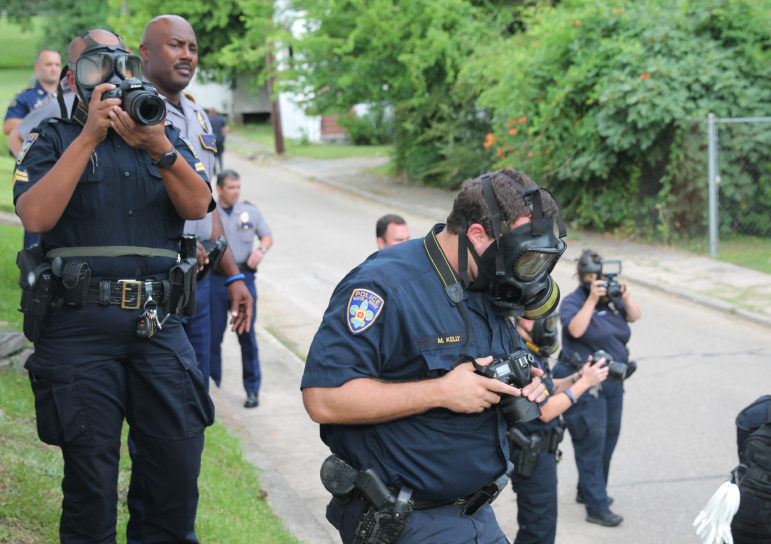
A police official justified the extraordinary use of force by saying protesters threw chunks of concrete. Despite the presence of at least three police photographers, a police spokesperson later said he is unaware of the existence of any images showing concrete being thrown.
An FBI alert warned of possible general threats to law enforcement, but if authorities knew of a specific threat during this protest, they did not share it with the public or the media.
In an attempt to be fair, I watched dozens — maybe hundreds — of videos while writing this article, hoping to link to the “concrete” throwing Edmonson spoke of. I found only two videos showing thrown objects. One was a water bottle. In the other, an object soared high into the air and did not appear to be a chunk of heavy concrete.
After Sunday’s chaos, Edmonson said, “I was certainly pleased with what I saw here.”
I was not. I saw absolutely nothing to warrant the militarized, violent and utterly terrifying police response I experienced on this Sunday afternoon. What I saw made me wonder how many more Baton Rouge residents have been subjected to police brutality. I wonder how many have gone unreported and uninvestigated.
I saw nothing to alleviate Jordan’s fear for her children’s safety, in fact just the opposite.
When I told one of the regulars in my cell I was a journalist, she went back to her bunk and returned with a piece of paper and a pencil.
“Write,” she said. “Please write about us.”
This story has been updated.
Karen Savage is a correspondent for the Juvenile Justice Information Exchange and is completing her master’s degree at the City University of New York Graduate School of Journalism. She reports on juvenile justice and social justice issues in New York and on the Gulf Coast.
It turns my stomach to read what you (and the other protesters) were put through. Although arrests can stem from peaceful protests, peaceful demonstration should not be countered with violence, and the handling of a peaceful protest should be done with dignity regardless.
You were subjected to pain and humiliation, which should NEVER be the case. EVER.
As a resident of Baton Rouge for the past 16 years and was among the protestors that marched to and from the state capital that very afternoon, I’m totally appalled and ashamed of the way the BRPD & Sheriff’s responded to peaceful protestors on July 9 & 10, 2016. Furthermore; the right to protest the MURDER of Alton Sterling should have been respected by this entire city, especially the BRPD being that your officers are responsible. BUT NO, now they are corralling, chasing, brutalizing, injuring, and arresting peaceful protesters who have the RIGHT TO ASSEMBLE AND MARCH AGAINST POLICE BRUTALITY!
I THOUGHT I WAS ASHAMED OF THIS CITY AFTER KATRINA, BUT I’M MORE ASHAMED NOW, AFTER READING THIS ARTICLE ABOUT THE TREATMENT OF PEACEFUL PROTESTERS HERE IN BATON ROUGE, LOUISIANA. MAYBE ITS WHY GOD ALLOWED THE SHOOTER TO COME HERE AND TAKE THE LIVES OF THE OFFICERS LAST SUNDAY MORNING.
JUST A THOUGHT!
Yes, I remember the horrible reaction in Baton Rouge after Katrina…this was a continuation of the same thing.
I’m a photojournalist who was arrested by NYPD during the Occupy protests. I hope Karen gets full documentation of her injuries for the upcoming legal proceedings. I’d be happy to share my experiences of that with her, so please pass on my info to her.
The above comment proves all I need to know about a person who calls themselves lemongello. A racist reaction to a very honest, objective report. I too have watched many videos and have seen nothing that required a militaristic attack on citizens of the United States, especially when you compare this to the two Bundy attacks on the the sovereignty of our country. What kind of response can a police chief expect when he leads such an attack on unarmed citizens? The shootings that followed are tragic and I condemn them as strongly as I condemn police state tactics. But what the hell did the police chief expect after using violence, violence on this day that piled up on a hundred years of violence. Thanks for sharing, Karen. You are a strong and beautiful woman, deep in her caring for people.
As it is posted, I should have referred to the statement just below, not above.
Wow!!! I cannot begin to express the depths of of so many different emotions!! We should all be grateful for people like yourself, that have the courage to bring the truth on this police state we live in. . & equally grateful for the people who get out & protests. . Making a huge sacrifice even, when it goes south such as it did in Baton Rouge. . I just can’t say enough about this story! I live in a small town in TN, & my husband & I are very active in many social justice organizations/activities…… you better believe if it ever comes close to us, we will be side by side w/ our brothers & sister!! Hugs to you & to all reading!! Keep fighting the good fight!!!! We shall overcome & find justice & peace!! #solidarity
This is hyperbole at its finest… shut the fuck up you piece of shit. Prison my ass, you went to jail for a few hours and you make it sound as if you were beaten by police, YOU WERE NOT! grow the fuck up and stop fueling the flames. Yes that is exactly what you, and like minded others, are doing. “I’m a reporter”, so what. This article is such bullshit, you created your situation and know you cry and whine like a five year old.
Hmmm. You use the phrase: ‘Like a five year old” to describe a journalist who provides a vivid yet calm account of her experience. What an interesting projection you offer.